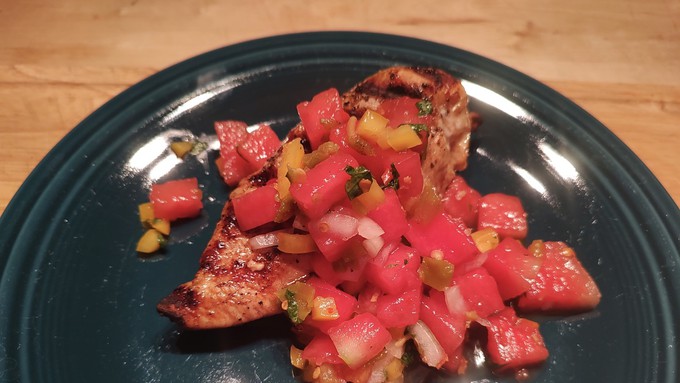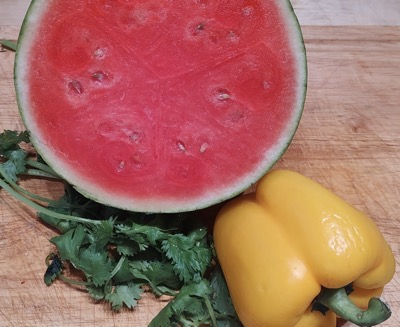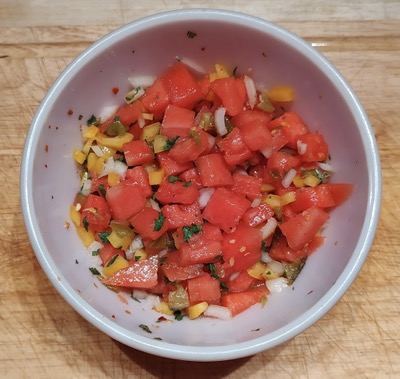
Recipe: Grilled chicken breasts with watermelon salsa

Grilled chicken gets a sweet-spicy spark of flavor from watermelon salsa. Debbie Arrington
What better way to end summer than with spicy watermelon salsa?
This combination makes the most of watermelon’s savory side while retaining its juicy sweetness. Watermelon salsa is a refreshing warm-weather topping for grilled chicken breasts. (It’s also great with pork tenderloin or sturdy tortilla chips.)
Grilled chicken breasts with watermelon salsa
Makes 2 servings
Ingredients:
¼ cup white wine
¼ cup olive oil

2 tablespoons balsamic vinegar
½ teaspoon seasoning salt
½ teaspoon coarse black pepper
2 chicken breasts, skinless and boneless
Instructions:
In a shallow dish, mix together wine, olive oil, balsamic vinegar, seasoning salt and pepper.
Pat dry chicken breasts and place in marinade, turning to coat. Refrigerate chicken breasts in marinade until ready to grill, at least 30 minutes.
Heat grill to medium. Grill chicken breasts for about 20 minutes, turning once, until done and juices run clear.
Serve chicken immediately with watermelon salsa.
Watermelon salsa
Makes about 4 cups
Ingredients:
1 tablespoon olive oil
2 tablespoons lime juice
½ teaspoon garlic salt
1 teaspoon crushed red pepper
1/3 cup cilantro, chopped
1/3 cup onion, diced
½ cup yellow or green bell pepper, diced
1 Hatch or Ortega chile, chopped (about 2 to 3 tablespoons)

3 cups watermelon, cubed and seeds removed
Instructions:
In a medium bowl, mix together olive oil, lime juice, garlic salt and crushed red pepper. Stir in chopped cilantro, onion, bell pepper and chilies. Fold in cubed watermelon. Chill until ready to use.
Note: Refrigerate extra salsa for later use.
Comments
0 comments have been posted.Sacramento Digs Gardening to your inbox.
Sites We Like
Garden Checklist for week of July 21
Your garden needs you!
* Keep your vegetable garden watered, mulched and weeded. Water before 8 a.m. to reduce the chance of fungal infection and to conserve moisture.
* Feed vegetable plants bone meal, rock phosphate or other fertilizers high in phosphate to stimulate more blooms and fruiting. (But wait until daily high temperatures drop out of the 100s.)
* Don’t let tomatoes wilt or dry out completely. Give tomatoes a deep watering two to three times a week.
* Harvest vegetables promptly to encourage plants to produce more. Squash especially tends to grow rapidly in hot weather. Keep an eye on zucchini.
* Pinch back chrysanthemums for bushy plants and more flowers in September.
* Remove spent flowers from roses, daylilies and other bloomers as they finish flowering.
* Pinch off blooms from basil so the plant will grow more leaves.
* Cut back lavender after flowering to promote a second bloom.
* It's not too late to add a splash of color. Plant petunias, snapdragons, zinnias and marigolds.
* From seed, plant corn, pumpkins, radishes, winter squash and sunflowers.